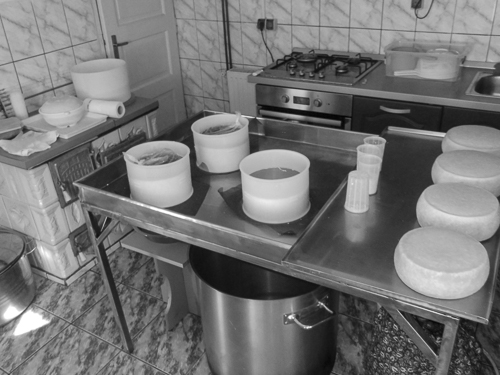Mr Dániel Tibor is apparently being a well-known man in Romania, having been on national TV and having visits from Prince Charles yearly!
In the past, they ran a guesthouse, but it was too much work. They bought their first cow 25 years ago, then they had 6-7 and now they have 18, 14 of which are giving milk, producing 100- 150 litres of milk a day. 8-10 years ago, the local county council arranged a cheese-making course and they both attended it. In fact, they had been experimenting with cheese-making before the course. Mr Dániel said that they learnt little at the course, but some theory was useful. Moreover, it was necessary to practise cheese-making outside the course. Now, they rise at 4 in the morning, milking the cows morning and evening and they are doing everything themselves. They make 22 types of milk products, some of which include:
⦁ cheese with pumpkin seeds
⦁ cheese with cumin
⦁ smoked cheese
⦁ cheese with mould
⦁ cheese with charcoal
⦁ fresh white cheese
⦁ cottage cheese
⦁ yogurt
In fact, Mr Dániel and his wife have developed their own palette and they are very proud that they can sell most of their cheese.
In addition to selling cheese to customers in Romania, they also export cheese to Israel and a contact person organises the export.
The Dániel couple has one son, who is 25 years old and he’s working in an agricultural council, helping farmers. He hasn’t decided if he wants to continue their work because he’s busy with his own work.
They are in touch with Mr Fülöp and they think he has too much to do like doubling the number of cattle in just 2 years.
Visiting the Dániel couple early in the morning, we were invited into their kitchen where they had prepared a wide variety of cheese. While we were tasting the cheeses, Mr Dániel talked about their farm. Having tasted a wide selection of cheeses, all I can say is that it’s a pity the Dániel couple live so far away from me, meaning that I won’t taste their cheeses for some time. Anyway, it’s perfectly understandable that their cheeses are so popular because they were just delicious.
The dairy was located in the kitchen in the basement and the storeroom for cheese was located nearby.
After the cheese-tasting, we went outside to have a look at the cows, but to my surprise they were all inside a barn. On my question of why, I was told that it was because of bears, the nearest good pasture was 12km away and the cows could get hurt walking there. There was another pasture nearby, but the quality was low.
I’ve been to farms like Eiker farmhouse dairy where the cows were free to go outside or stay inside, but most of them stayed inside. Maybe farmers have been breeding animals, which require little exercise? Maybe the cattle which was too energetic wasn’t allowed to breed? However, transhumance, meaning man bringing animals to the mountains in summer and to the valleys in winter, has been practised for millennia worldwide and there are certainly both hills and valleys in this area. Anyway, even cows which are outside, like at the Milk mine, hardly get any exercise. They just walk from the barn to the pasture and back again, a walk which requires a couple of minutes. Else, they go grazing or lie down, ruminating.
The likely explanation for the delicious cheeses are what the cows are eating. For instance, Mr Fülöp said that the buffaloes needed to eat hay in winter in order to produce good milk.
During our visit, we could see that Mr Dániel’s wife was heating aubergines in a wood-fired oven and she had picked a lot of rose hip. Her husband accompanies her when she’s picking herbs because of bears. In addition to selling cheese, they also make jams and herbal teas for sale.
In general, the biggest problem is to get workers because so many have emigrated. Unfortunately, this is a problem for many of the producers we have visited.
We followed Mr Dániel a short distance from where we could see a big pile of hay required for one year’s consumption. While outside, we could see that the farm was surrounded by steep hillsides and deciduous forests and we could see rolling hills on the other side of the village.
Mr Dániel plans to apply for a grant to make work on the fields more easy, but more mechanisation can only contribute a little to work on the farm.




